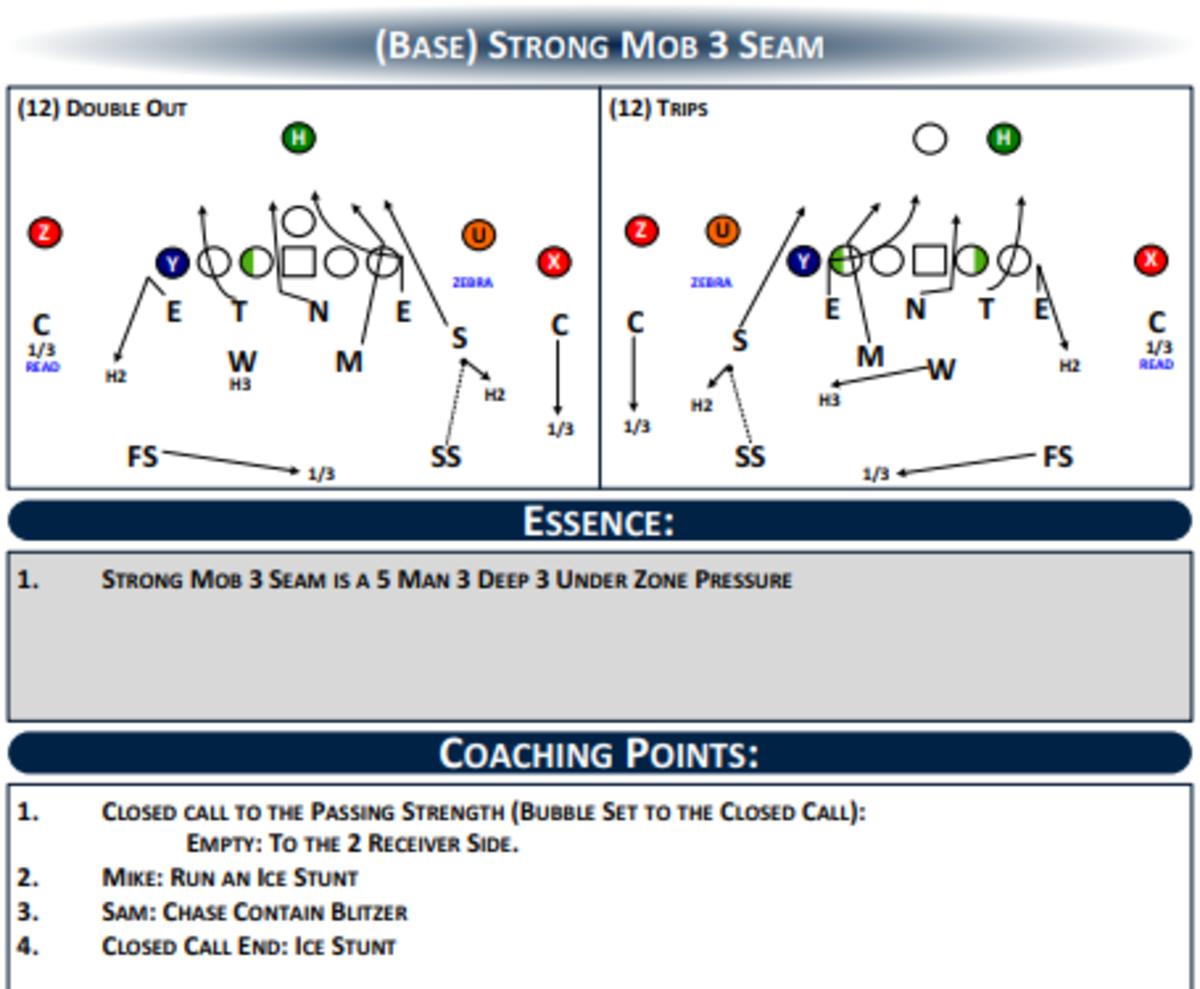Film Breakdown: Jordyn Brooks Adds Weapon to Seahawks Blitzing Arsenal
This is the second article in a five-part Jordyn Brooks film breakdown:
Part 1: Evaluating Seahawks LB Jordyn Brooks' Coverage Skills
Part 2: Jordyn Brooks Adds Weapon to Seahawks Blitzing Arsenal
Part 3: Jordyn Brooks Brings Run Dominance to Seahawks
Part 4: Seahawks LB Jordyn Brooks Has Elite Fundamentals
Part 5: Did Seahawks Reach Selecting LB Jordyn Brooks at No. 27 Overall?
Jordyn Brooks solved a big problem for Texas Tech.
In a Big 12 division where the spread is king, most offenses hit their chunk plays way beyond conventional linebacker zones deep down the field. The ball also comes out super fast, to extremities way beyond linebackers.
Another impact of the powerful passing attacks has been odd fronts that consist of a three-man pass rush becoming commonplace. Teams have been creative in trying to get as many coverage-focused players as possible.
From these looks, finding a way to generate pressure versus quarterbacks is difficult, particularly when positioning the three defensive linemen in the interior gaps à la tite front (4i-0-4i/B Gap-A Gap-B Gap). The tight alignment aimed at pushing the run outside restricts the pass rush spacing. Luckily for the Red Raiders, Brooks was often the answer to this issue.
Blitzing
The numbers suggest Brooks was a dominant success at generating pass rush. Pro Football Focus logged Brooks as having 44 pressures on 117 off-ball pass rush reps in his senior campaign, a pressure rate of 38 percent. Those 2019 numbers are somewhat "fake," as Brooks was used regularly as an "insert rusher," only blitzing when he got a pass read. This would turn the three-man rush into a four-man squad.
The path to "insert rush" pressures tends to be simpler from a physical standpoint. But getting pressures when insert rushing does require high IQ skills. Brooks was able to quickly diagnose run or pass and was elite at processing pass protection schemes.
“It was something that I got to do a lot in last year’s system,” Brooks reflected on his 2019 pass rushing. “I didn’t get as many sacks as I wanted to but I definitely got back there, caused a lot of disruption in the backfield.”
Brooks’ interior reps of 2019 translate to Seattle’s MIKE or WILL linebacker positions; with both roles blitzed though the A or B gaps - mainly the Seahawks run man coverage behind it. Seattle will also indicator-match sprint outs and other pocket movements by letting the weak hook attack the quarterback - Brooks style. John Schneider applauded the linebacker’s ability blitzing interior gaps.
“He’s actually really good rusher from the A-Gap, inside stuff too,” the Seahawks general manager praised in the aftermath of selecting Brooks in the first round.
Brooks was sudden, slippy, and violent when conventionally blitzing. He was often too quick for blockers. He was able to run the hoop when on twists, keeping his path tight thanks to pliability. He was patient for set ups, waiting for the opening. He tricked blockers with cunning, shimmying footwork. He violently contacted pass protection with shoulder strikes and swipes, exploding upwards. His blitzing was full of hustle, an insatiable appetite for the football prevalent.
Most impressive is Brooks’ ability to get skinny and maintain balance through contact to squeeze into backfields.
“I feel really comfortable getting by offensive lineman, offensive tackles, offensive guards, whatever they want me doing,” Brooks revealed after being taken by the Seahawks.
One of the keys is Brooks' ability to work his flipper as he slips through footwork-created openings. This prevents him from being blindsided into the turf and allows him to close.
Brooks’ feel for offensive schemes and open lanes naturally extends to disruption of passes where the offense showed run action. Free to go quarterback hunting after eliminating the threat of the run (thanks to his insert blitz assignment), Brooks took his shots and rewarded his own initial restraint. On bootlegs, RPOs, or regular play action, he caused grave problems for pass protection. Brooks was able to win back to the right spot, finding the daylight, getting to the evil passer. This was game-wrecking stuff.
Going back to the previous Texas Tech regime where Brooks played his first three years, the linebacker was sent off the edge in reps that were like Seattle’s SAM linebacker deployment. When running 4-3 as their true base defensive personnel, the Seahawks loved their five-man, three-deep 3-under fire zones that regularly used the SAM linebacker as the contain rusher, attacking from wide areas.
Cover 3 seam rush zones were a way of helping a stagnant pass rush and also encouraged the quick throw to the short option in the flats. The defense could then rally up to tackle. It prevented three linebackers being overly stressed in coverage and was particularly useful on early down passes from three wide receiver sets.

Depending on the defensive family Seattle is in, the WILL can also get edge rush calls.
“The WILL and the SAM ‘backer, if you watch our film last year, they are inside and outside, coming off the edge, playing behind the line of scrimmage, they really have to do all of it,” Pete Carroll commented when envisioning Brooks’ role in the Pacific Northwest.
In these perimeter chances, Brooks being too fast for protection calls really showed up. Like when the Seahawks put their Sam down at the line of scrimmage, and they do this often, opposing offenses of TTU could not be certain of whether Brooks was coming after the quarterback or dropping back into coverage. Any hesitation was punished by Brooks off the edge.
All of the positive elements to his interior rush were present from the exterior too. A degree of hip rigidity stops Brooks from being truly freaky at reducing corners, but he has enough bend through contact to beat tackles around the edge. What was really nice was his ability to rip through when rushing and pull short tackle sets around. A lot of attacks chose to give a running back the unenviable task of picking Brooks up. He bullied this decision with with strong hands swatting, swiping, and punching.
The main challenge for Brooks in the pros coming off the edge will be dealing with deeper sets from offensive tackles that are more aware of him coming. The NFL has a drop back passing game that doesn’t really exist in the Big 12. The key for Brooks to enjoying sustained success against these challenges will be leaning on his manipulative footwork. Like most rookies, he will need to hone his handwork into a more a definitive pass rush move or two. His club and swim moves are a promising base.
Unsurprisingly, Brooks’ blitzing ability extends to going after the ground game. Sure, running is inefficient and angers the analytics community. Yet it’s a safe bet that the vast majority of NFL coaches believe in the ground game more than the numbers say they should. Brooks can punish them for this and his tackles for loss will kill drives.
The Big 12’s beloved run against the odd fronts like tite is guard tackle-wrap/counter. The backside guard and tackle pull, leaving the backside end defender on the line of scrimmage unblocked. The quarterback can read him, with pass and run options existing off this key.
Brooks, though, was different. guard tackle-wrap away from his blitzing was a futile exercise. He wasn’t supposed to make the tackle, hence why offenses thought they could leave him unblocked. Yet, he was too damn fast to key and run, honoring the quarterback run threat before scraping to the running back away from him for the tackle for loss.
Getting to inside zone run away from Brooks was astonishingly comfortable for him too. Understanding what he was facing, Brooks was able to explode past down blocks and get skinny into the backfield. His film versus Texas in 2018 shows what he does to a C-gap blocker.
Blitzing at the front side of runs, Brooks’ elusive style and ability to penetrate blocks was highly problematic for opposing offensive lines too. Look at this play versus Oklahoma State, as he forces a hold after dipping inside for what would have been a tackle for loss. More negative offensive plays took place. Offensive concepts were crossed out on the call sheet.
2019 saw the interior destruction take off. It was occasionally difficult to decipher whether Brooks was blitzing or just keying incredibly well thanks to his superb football intelligence. Still, just marvel at the supreme interior blitzing versus the run.
Brooks got into backfields with frightening regularity, swimming, ripping, euro-stepping his way into plays. Teams legit had to change their offensive approaches in game, after presumably spending all week game planning for runs that would work against Brooks. All of the spicy inside pass rush elements existed versus the run too. Brooks found a variety of ways to beat blocks and won deep into backfields. He knew where his help was, or should have been coming from, and won to his spot and more.
The last clip in this video, versus Iowa State, deserves more talk because as the "set-up" man on the cross dog blitz, Brooks managed to stun and disengage to the cutting back runner. It’s a continuation of the theme of the scrappy linebacker making plays he’s not supposed to make.
Brooks has the blitzing traits to be a huge irritant attacking from strongside linebacker, middle linebacker, or weakside linebacker, making him an absolute weapon. His comprehension of how to beat a variety of pass protection and run blocking schemes combines with his physical and technical tools to make him a frightening proposition for offenses.
Brooks’ nose for the football is not restricted to blitzing. When playing regular run fits, the linebacker was outstanding too and nearly every play was a highlight. Read Part 3 of this extensive film study as I uncover the rare skill set Brooks will bring to Seattle’s run defense.
